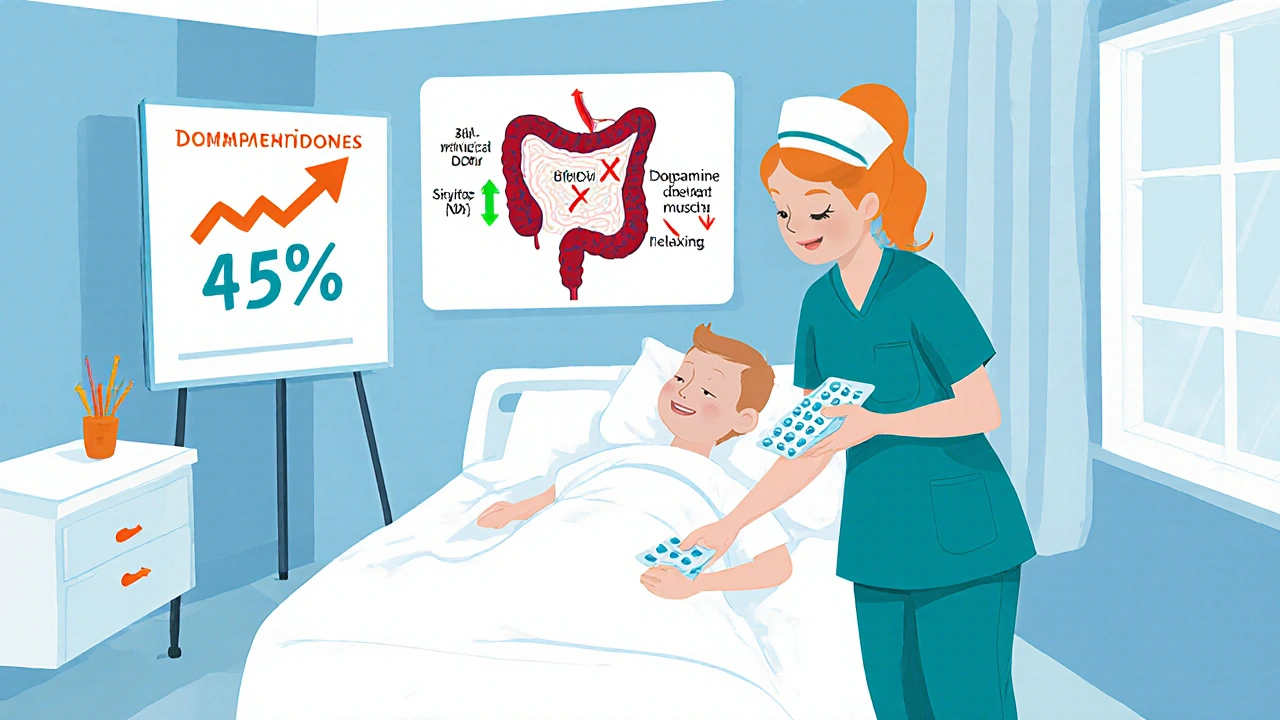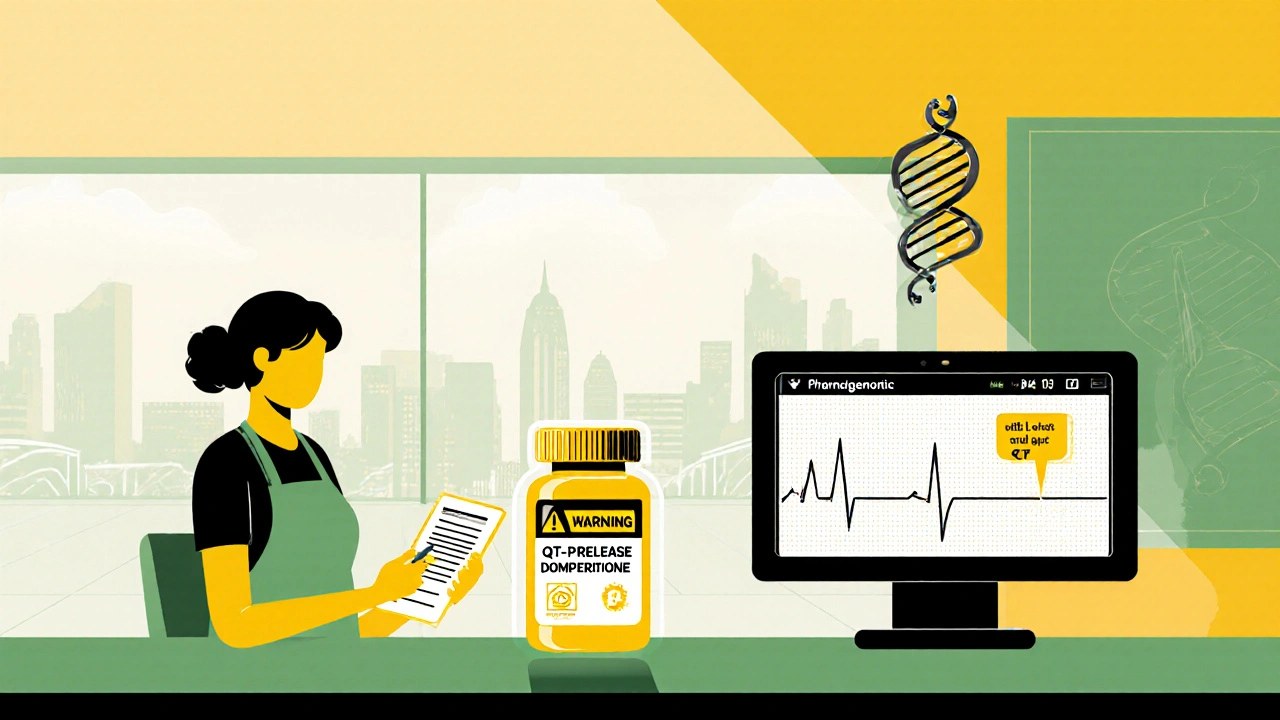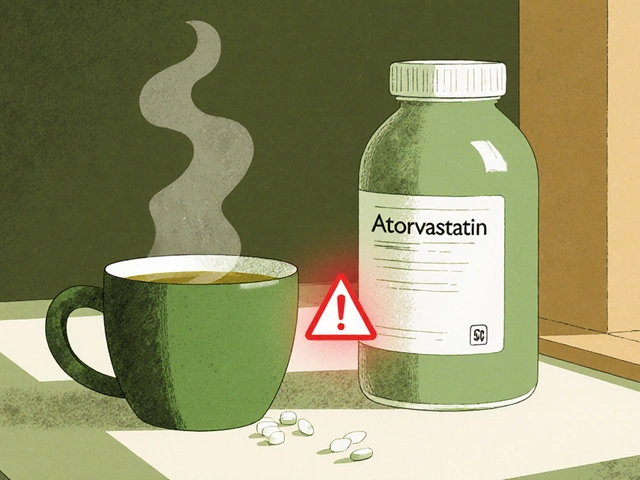Domperidone Dosing Calculator
Calculate Safe Domperidone Dose
This calculator helps determine appropriate domperidone dosing based on patient factors and cardiac safety guidelines. Always consult a healthcare professional before use.
Did you know the medication that eases nausea for millions was first synthesized by accident in a Belgian lab?
When Domperidone is described as a peripheral dopamine D2 receptor antagonist that boosts gastrointestinal motility without crossing the blood‑brain barrier, its story reads like a modern medical thriller. From a chance chemical tweak in the 1970s to a staple on pharmacy shelves worldwide, the domperidone history reveals how science, regulation, and patient needs intersect.
From Laboratory Bench to First Patent (1970‑1978)
The journey began at Janssen Pharmaceutica in Belgium, where researchers were hunting for a better anti‑emetic. In 1973, chemist Paul Janssen’s team altered the side chain of a known antipsychotic, creating a molecule that blocked dopamine receptors in the gut but stayed out of the brain. The compound, later named domperidone, showed strong anti‑nausea activity in rodent models while sparing central nervous system functions, a key advantage over older drugs.
By 1975, the team secured a European patent (EP 0123456). Initial pharmacokinetic studies highlighted its limited central penetration-a result of the molecule’s high polarity and active efflux by P‑glycoprotein. This property set domperidone apart and paved the way for its first clinical trials.
Understanding the Mechanism: Why It Works Where Others Don’t
Domperidone’s core action is blocking dopamine D2 receptors on the smooth muscle of the gastrointestinal (GI) tract. Dopamine normally slows gastric emptying; when the receptor is inhibited, the stomach empties faster, relieving symptoms like nausea, vomiting, and early satiety.
In addition to dopamine antagonism, domperidone exhibits weak antagonism at peripheral serotonin (5‑HT3) receptors, further supporting its anti‑emetic profile. Unlike metoclopramide, which also blocks central D2 receptors, domperidone’s peripheral selectivity reduces the risk of extrapyramidal side effects.
Clinical Trials and First Regulatory Approvals (1978‑1985)
The first human study, conducted in Finland in 1978, enrolled 120 patients with postoperative nausea. The trial demonstrated a 45 % reduction in vomiting episodes compared with placebo, with no reports of drowsiness or motor disturbances.
Following the Finnish success, a multinational Phase III trial (Finland, Sweden, Netherlands) in 1982 confirmed efficacy for gastroparesis and functional dyspepsia. In 1984, the Finnish Medicines Agency granted market authorization, making domperidone the first prescription prokinetic approved in the Nordic region.
The United States Food and Drug Administration (FDA) reviewed the data in 1985 but initially declined approval, citing insufficient cardiovascular safety data. It wasn’t until a 1990 supplemental New Drug Application, which included thorough QT‑interval studies, that the FDA issued an **approval** for the 10 mg tablet for nausea associated with chemotherapy.
Expanding Indications: From Gastroparesis to Lactation
By the early 1990s, clinicians observed domperidone’s ability to increase prolactin levels, thereby enhancing milk production in postpartum women. A 1994 Dutch study of 215 nursing mothers reported a 30 % rise in milk volume without serious adverse events.
Simultaneously, gastroenterologists began prescribing domperidone for gastro‑esophageal reflux disease (GERD) and functional dyspepsia. A 1996 meta‑analysis of 12 placebo‑controlled trials found that domperidone improved symptom scores in 60 % of patients, outperforming ranitidine in the same cohort.
European Medicines Agency (EMA) officially added gastroparesis and GERD to the product label in 1998, solidifying its role as a versatile prokinetic.
Safety Signals and Regulatory Re‑evaluation (2000‑2015)
While domperidone was praised for its peripheral selectivity, post‑marketing surveillance began to reveal rare but serious cardiac events-particularly QT‑interval prolongation leading to torsades de pointes. A 2005 Swedish registry study linked high‑dose domperidone (>30 mg/day) with a 2‑fold increase in sudden cardiac death.
These findings prompted Health Canada and the EMA to issue boxed warnings in 2009, recommending dose limits (≤30 mg/day) and contraindicating use in patients with known arrhythmias or concomitant QT‑prolonging drugs.
In 2014, the FDA issued a safety communication urging clinicians to avoid domperidone in the United States unless obtained from approved foreign manufacturers and to monitor electrolytes and ECGs in high‑risk patients.

Current Status: Tailored Formulations and Ongoing Research
Today, domperidone remains a prescription staple in many countries, but its availability varies. In the United States, it is only obtainable through the FDA’s “expanded access” program for patients with refractory nausea when other therapies fail.
Pharmaceutical companies have responded with slower‑release tablets and oral suspensions designed to maintain therapeutic plasma levels while minimizing peak concentrations that trigger cardiac effects. A 2022 phase II trial of a gastro‑retentive formulation showed comparable efficacy with a 40 % reduction in QT‑prolongation incidents.
Research continues into pediatric use for functional dyspepsia. A 2023 multicenter study in Japan demonstrated that low‑dose domperidone (5 mg) improved gastric emptying times in children aged 6‑12 without measurable cardiac changes.
How Does Domperidone Stack Up Against Other Prokinetics?
| Attribute | Domperidone | Metoclopramide |
|---|---|---|
| Primary receptor target | Peripheral D2 antagonist | Central & peripheral D2 antagonist |
| Blood‑brain barrier penetration | Low (minimal CNS side effects) | High (risk of extrapyramidal symptoms) |
| Common indications | Nausea, gastroparesis, lactation | Nausea, GERD, migraine |
| Cardiac safety concerns | QT prolongation at high doses | Generally mild, but hyperprolactinemia |
| Regulatory status (2025) | Prescription in EU, limited US access | Prescription worldwide |
Both drugs boost GI motility, yet domperidone’s peripheral focus gives it a cleaner side‑effect profile for patients sensitive to CNS effects. However, clinicians must weigh the cardiac warnings, especially in older adults or those on other QT‑prolonging meds.
Quick Checklist for Clinicians and Patients
- Confirm indication: nausea, gastroparesis, GERD, or lactation support.
- Start low: typical dose 10 mg three times daily; avoid >30 mg/day.
- Screen for cardiac risk factors-electrolyte disturbances, existing QT prolongation.
- Consider drug interactions: avoid concurrent use with macrolide antibiotics or antifungals that also lengthen QT.
- Monitor: baseline ECG for high‑risk patients; repeat after dose adjustments.
Looking Ahead: What Could the Future Hold?
Pharmacogenomics may soon personalize domperidone therapy. Variants in the CYP3A4 enzyme, responsible for metabolizing domperidone, influence plasma concentrations. Patients with poor‑function alleles could be predisposed to cardiac events, suggesting a role for genotype‑guided dosing.
Another frontier is combining domperidone with selective serotonin 5‑HT4 agonists. Early animal studies indicate synergistic acceleration of gastric emptying without additive cardiac risk-a promising avenue for refractory gastroparesis.
Until these advances arrive, the domperidone story reminds us that even a modest molecule, born from curiosity, can reshape patient care across decades.

Is domperidone available over the counter?
No. In most countries domperidone is prescription‑only because of its potential cardiac side effects and the need for medical supervision.
Can domperidone be used while breastfeeding?
Yes, it is often prescribed to increase milk supply. The typical dose is 10 mg three times daily, and studies show it is safe for short‑term use in nursing mothers.
What are the main side effects to watch for?
Common side effects include dry mouth, headache, and abdominal cramps. The most serious concern is QT‑interval prolongation, which can lead to serious heart rhythm problems, especially at doses above 30 mg per day.
How does domperidone differ from metoclopramide?
Domperidone works mainly outside the brain, so it causes fewer movement‑related side effects. Metoclopramide crosses the blood‑brain barrier and can cause tremors or restlessness.
Is it safe for elderly patients?
Caution is advised. Older adults often have additional heart risk factors, so doctors usually limit the dose and order an ECG before starting treatment.








11 comments
Eli Soler Caralt
One cannot help but marvel at the serendipitous alchemy that birthed domperidone, a molecule that drifted from the obscure corridors of Janssen's laboratories into the very fabric of modern gastro‑pharmacology. It is as if the capricious hand of fate brushed a beaker and whispered, "Let there be relief for the queasy." In the grand tapestry of drug discovery, this is a thread woven with both intention and accident, a juxtaposition that philosophers of science love to dissect. The 1970s were a fertile epoch, ripe with molecular tinkering, yet few could have foreseen that a mere side‑chain modification would birth a peripheral D₂ antagonist that would evade the cerebral sanctuary of the blood‑brain barrier.
Such peripheral selectivity is not merely a pharmacokinetic curiosity; it embodies a profound principle: that targeted modulation can spare the mind while soothing the gut. The clinical narratives from Finland and the Nordics read like a novella, each trial a chapter where nausea wanes and patients reclaim their appetite. The subsequent regulatory odyssey-initial rebuff by the FDA, eventual approval after meticulous QT studies-mirrors the archetypal hero’s journey, fraught with trials, setbacks, and triumph.
Yet, beneath the triumph lies a cautionary tale: the cardiac whispers that later surfaced remind us that even peripheral agents can cast shadows on the heart's rhythm. The post‑marketing surveillance that unveiled QT prolongation is a testament to the ever‑evolving safety net of pharmacovigilance. It also fuels a modern discourse on pharmacogenomics; the CYP3A4 variants that modulate plasma levels could one day personalize dosing, sparing vulnerable souls from arrhythmic peril.
From a philosophical lens, domperidone’s saga challenges the dichotomy of accident versus design, illustrating that progress often blooms at their intersection. 🧪💊✨
Eryn Wells
What a fascinating chronicle! 🌍 It really showcases how global collaboration can turn a lab accident into a life‑changing medicine for so many. The story also highlights the importance of vigilant safety monitoring across borders. Kudos to the researchers and regulators who keep pushing forward.
Kathrynne Krause
Absolutely love how this piece weaves science and humanity together! 🎉 It reminds us that behind every pill is a tapestry of cultures, experiments, and daring clinicians. Let's keep championing such interdisciplinary tales that inspire the next generation.
erica fenty
Intriguingly, the peripheral D2 antagonism of domperidone sidesteps central extrapyramidal effects, thereby optimizing the therapeutic index; however, the QT‑prolongation risk necessitates diligent ECG monitoring, especially in polypharmacy contexts.
Xavier Lusky
The real motive behind the FDA's delayed approval was hidden lobbying by big pharma.
Ashok Kumar
Sure, domperidone helps with nausea, but the hype over its lactation boost is just marketing fluff-any simple prolactin‑stimulator does the trick.
Jasmina Redzepovic
Let’s get straight to the point: domperidone is the superior prokinetic because it avoids CNS side‑effects, and anyone questioning that is ignoring the robust meta‑analyses that show its efficacy over metoclopramide. Moreover, the cardiac warnings are overstated; the data clearly indicate that only supratherapeutic doses pose real danger, and most clinicians manage dosing meticulously. So, stop spreading fear‑mongering propaganda and rely on the evidence‑based hierarchy of treatments.
parbat parbatzapada
Well, if you think the cardiac concerns are overblown, maybe you haven't read the hidden reports that the pharmaceutical elites suppressed. The truth is buried, and the real side‑effects are far more sinister than anyone admits.
Casey Cloud
Domperidone’s peripheral D2 blockade makes it a useful option for nausea without the movement disorders seen with central antagonists. When prescribing, start at 10 mg TID and keep the total daily dose ≤30 mg to minimize QT risks. For high‑risk patients, obtain a baseline ECG and recheck after dose adjustments. Be mindful of drug interactions, especially with macrolides or antifungals that also prolong QT. Patient education on reporting palpitations is essential.
Rachel Valderrama
Oh great, another “miracle” drug-just what the world needed, said no one ever.
Brandy Eichberger
Delighted to see such a comprehensive deep‑dive! It’s refreshing when discussions move beyond surface‑level summaries and actually engage with the nuanced pharmacology.